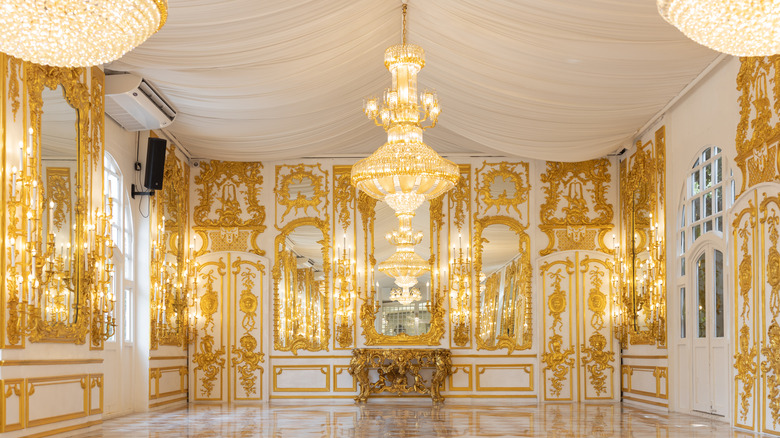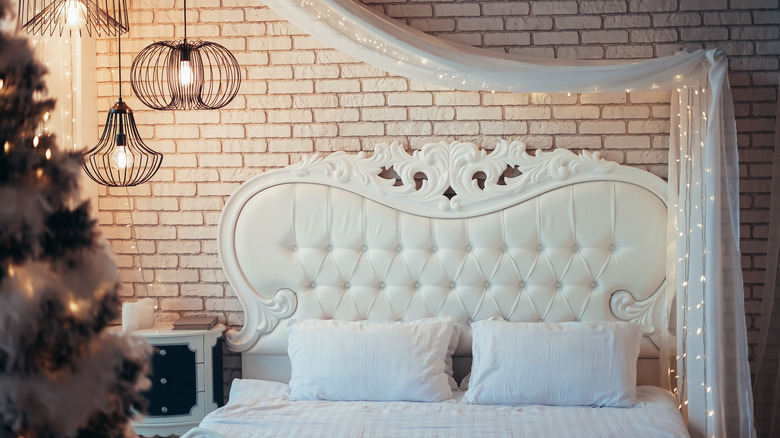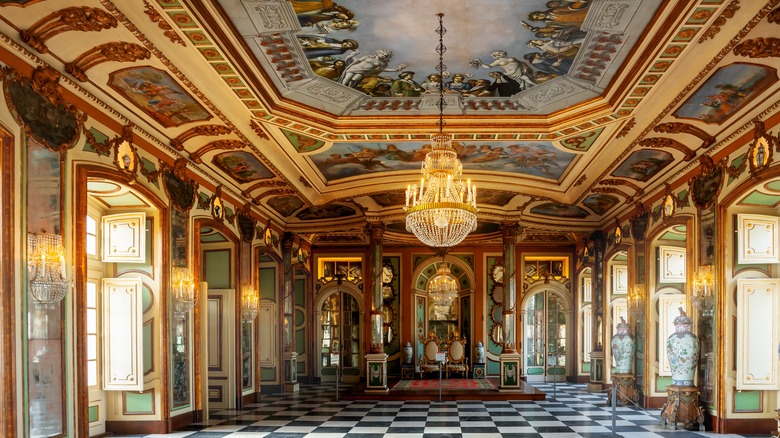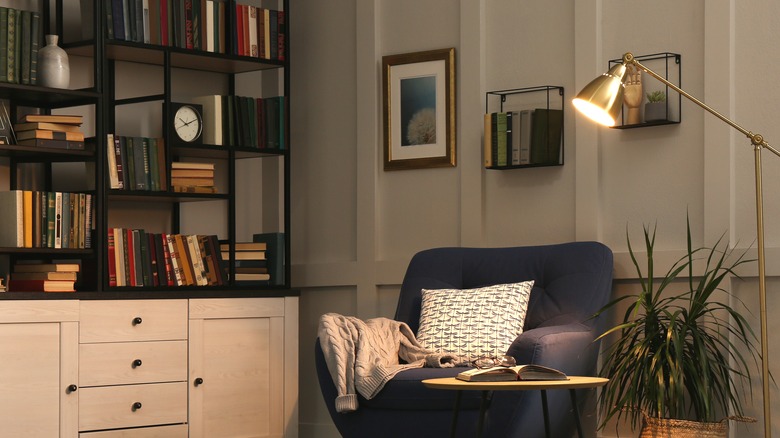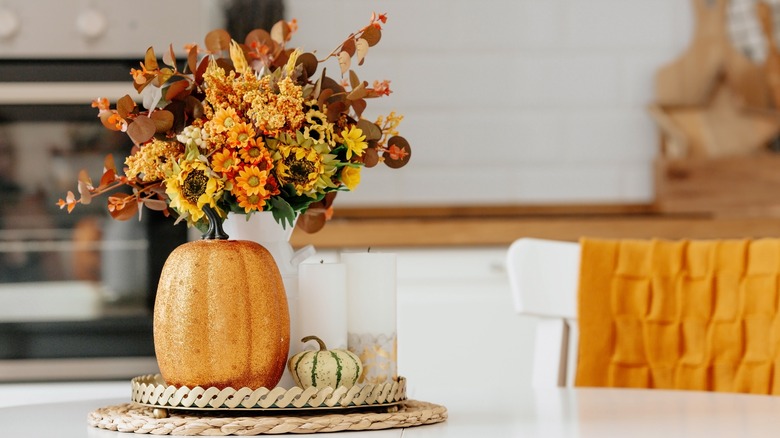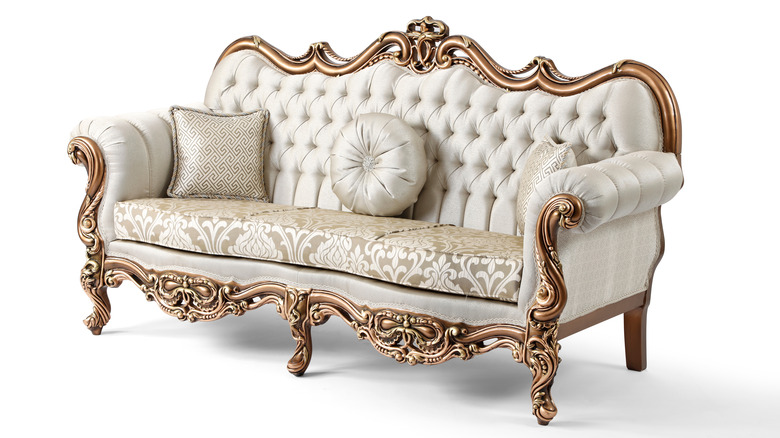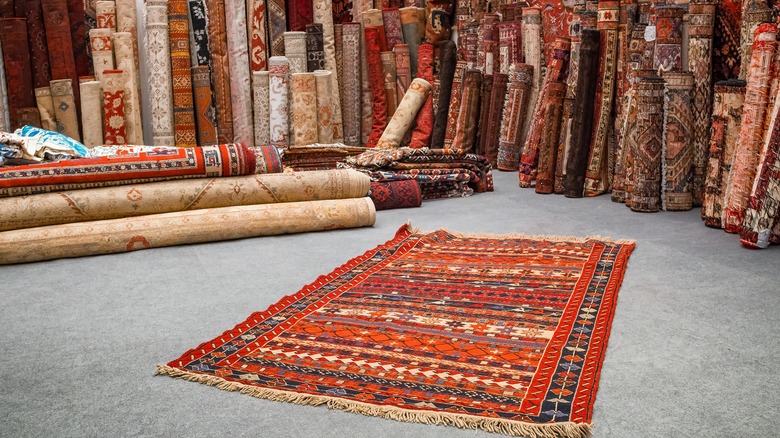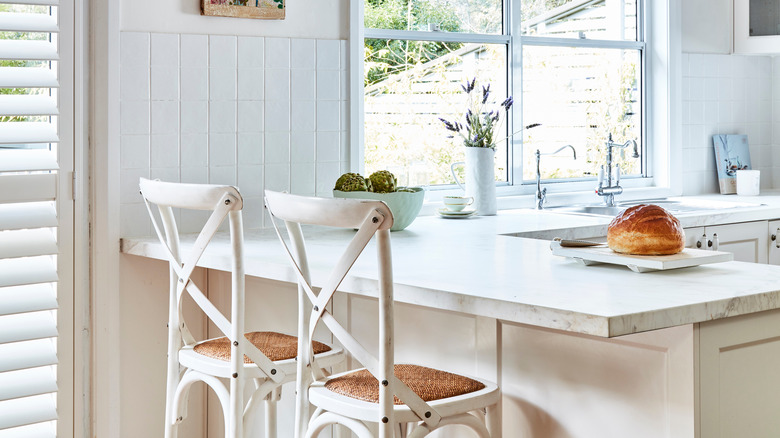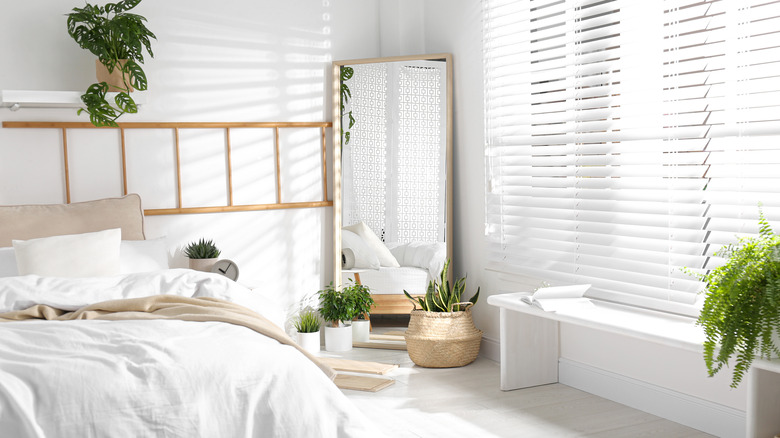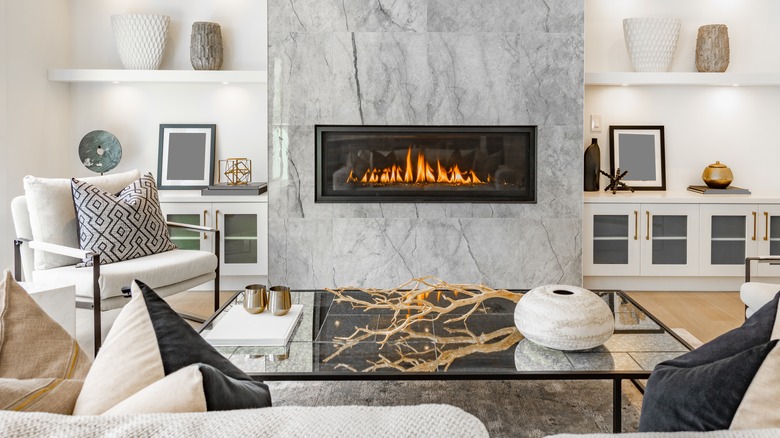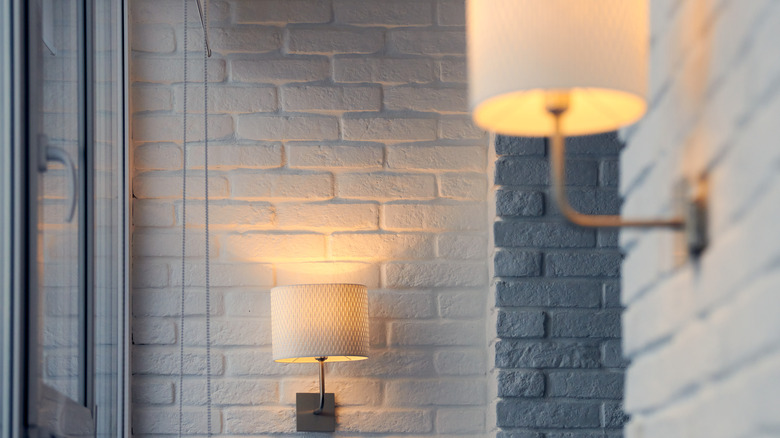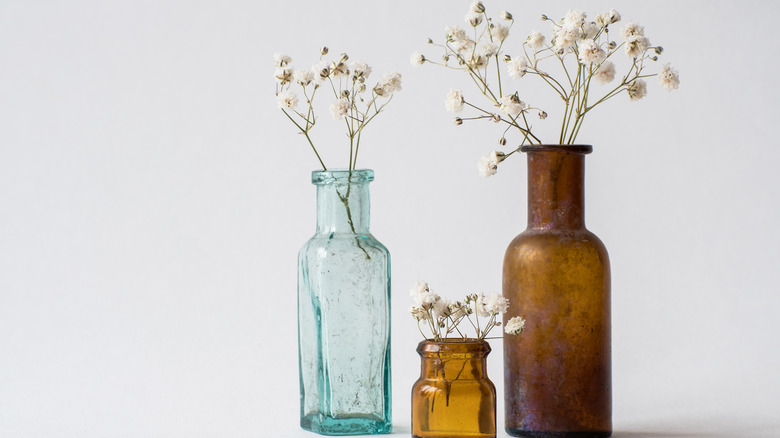The Ultimate Guide To Baroque Decor
If you've walked into a thrift store or flipped through photos from the 18th century, chances are you've seen baroque-inspired pieces and architecture. According to the Victoria and Albert Museum, baroque was a popular style of art, design, and architecture that spread throughout Europe in the 17th and 18th centuries. Baroque was a unique movement because it focused on taking a stance and sending a message, while also appealing to people's intellect and emotion.
Baroque architecture was known for its iconic frescos and stucco walls (via MasterClass). The origin of the baroque movement in architecture stemmed from the Catholic Church after the Protestant Reformation. The Vatican was pushing for a move away from it's old gothic style, into something that was more Roman-inspired. Baroque gave way to the rococo style movement, and eventually the term baroque came to encompass a broad variety of Victorian-era designs and architects.
Blend with neoclassical elements
Even though they're on opposite spectrums in terms of how ornate their architecture and art were, neoclassical and baroque design are commonly grouped together. Both art movements appeal to emotion, logic, and beauty in different ways. According to Boise State University, the neoclassical movement, or the classic revival, was going on during the same period of history as baroque and rococo. Baroque and rococo focused on bright colors, asymmetry, and ornate pieces, while neoclassical focused on symmetry and simplicity. Neoclassical design takes its inspiration from classical Greek and Roman elements and philosophy. Similarly, baroque architecture was influenced by classicism and the Renaissance movement in Rome (via MasterClass).
Incorporating shared neoclassical elements into your space is a great way to bring baroque design into your home without it being overly ornate. Neoclassical-inspired interiors commonly have a mild color palette that focuses on white, cream, green, yellow, and other muted shades. A great way to work this into your space is using vintage rugs with delicate colors, or swapping out existing chair legs for fluted ones.
Take inspiration from baroque architecture
According to The Collector, baroque architecture was heavily inspired by the Catholic Church in response to the Protestant Reformation, which focused on architecture that was minimalistic and clean. Baroque architecture, by contrast, was intentionally dramatic and was meant to be a metaphor for the realm of Heaven. When looking to bring baroque into your home, a great place to start is the architecture from that movement. Because baroque was designed to aid the Catholic Church, it was known for grand symbols and designs that caused emotional reactions. The architecture featured complex shapes and multiple materials. It was also common in baroque interiors to have painted ceilings or ones gilded with gold.
Today, we may not be able to rebuild our homes to incorporate baroque style architecture, but we can incorporate curves into our interior design. For example, adding in curved archways or sculptural furniture pieces with rounded silhouettes can make a room appear cozier and more open. Additionally, we may also not be able to paint murals on our ceiling, but we can put up wallpaper. While hanging wallpaper on a ceiling may seem daunting, experts recommend starting at the edges of the room and working your way in to make the job more seamless (via YouTube).
Decorate with vintage pieces
Vintage pieces are a fun way to work baroque style into your home. According to the Victoria and Albert Museum, baroque pieces were known for their precious and rare materials. For example, items that were porcelain or lacquered, especially when imported from East Asia, were coveted by Europeans and even imitated. These pieces were proudly displayed in baroque homes. Additionally, furniture pieces that featured marquetry were popular. Furniture and decor pieces that had motifs, often of animals or intricate floral patterns, were also common.
If you want to work vintage pieces into your home, it's important to pay attention to the rules of proportion and scale (via Space Wise). You can also group similar items when displaying them to create a cohesive look and visual interest. Additionally, antiques make great focal points for rooms and are great items to decorate around. For example, using vintage mirrors not only allows light to bounce around your room, but it also draws the eye (via Suzie Anderson Home on YouTube). You can also thrift little, rare decorative items — like trays, books, or vases — to bring in small accents to your space.
Decorate with damask fabrics
One of the most famous baroque details is their use of luxurious fabric, especially damask. According to MasterClass, damask is a reversible patterned fabric that is woven with a jacquard-loom. Damask can be done on many textiles, like silk, linen, wool, or cotton. These textiles are sought after, especially in design, because they are a strong woven fabric that's durable, making it perfect for chair and couch upholstery. The fabric is also reversible with the same pattern on both sides, making it perfect for high touch surfaces that stain easily.
Damask patterns can also be found in a variety of wallpaper shades (via Houzz). Depending on the color scheme you pick, you can make a room look bold or artistic. You can also use a light colored damask pattern to contrast a bold floor or statement piece. Additionally, gray damask wallpaper is a sought after shade because of its versatility and ability to bring a Georgian flare into contemporary homes (via F&P Interiors). While mute colors are a great way to bring versatility into your space, you can also get metallic or textured damask wallpaper, which is known for its luxurious feel.
Work in florals
Another iconic element of traditional baroque style is its use of floral prints. According to Provincial Fabric House, if you want to decorate with floral prints, you can use an upholstery fabric you like and create a color scheme from it. This helps make a cohesive look thats modern. You can also swap out your existing bedspread for a floral one, or use a more modern watercolor floral fabric, to reupholster your chairs. Additionally, hanging floral window treatments or shower curtains is a great and modern way to bring in a baroque element, without spending a lot of money or time (via Saffron Marigold). In your space, you can also work floral pillows into your design. It's recommended that, when using bold prints, you place large patterns next to smaller ones.
If you don't want to work with floral prints, you can decorate with actual flowers, and there are many different ways to do so. For example, daisies complement small vases because of their thin stems. They pair well with mint, basil, and wildflowers. Peonies are statement flowers with thick stems, making them perfect to display in a pitcher. They also pair well with any neutral colored flower or greenery. If you choose to decorate with roses, they're versatile and can be placed into virtually any vase that's tall enough (via On Sutton Place).
Decorate with Louis-inspired pieces
One of the most iconic furniture styles in baroque interior design is the Louis style. According to Suphan Classic Home Co., there are four eras of Louis furniture: XIII, XIV, XV, and XVI. Each Louis style represented different monarch reigns and differentiated in style. For example, Louis XIII furniture was elaborate, but Louis XIV furniture was significantly more conservative.
Today, Louis XVI furniture is the most popular. These pieces have straight lines and sharp angles, unlike previous Louis furniture, which featured bow legs and curves. Louis XV was known for its cabriole legs, while Louis XVI furniture had fluted or reeded legs. Additionally, Louis XVI furniture was made of oak, mahogany, ash, ebony, copper, steel, porcelain or marble, but furniture was usually painted with a lacquer or varnish.
When looking to purchase vintage furniture, like Louis-inspired pieces, you can attend estate sales, auctions, flea markets, antique stores, or find them on social media (via Lynchburg Living). You can also add or change the existing legs on your furniture to match Louis-era pieces. Some furniture legs may screw off easily, but if your piece has glued legs, you can wedge it off with a screwdriver and hammer (via YouTube).
Use Oriental rugs
Baroque is known for its ornate details, like its use of Oriental rugs. According to Claremont Rug Company, there are many ways to use these rugs to compliment your space. For example, in large rooms with high ceilings, rugs with deeper and contrasting colors work well, while lighter colored rugs will get lost and look washed out. Additionally, medallion style rugs will add elegance and visual interest to a room. Oriental rugs can also be used as focal points in a room. You can also use multiple rugs in a living or bedroom, especially if its a large space, to bring warmth and a sense of comfort. For bedrooms, you can place two small rugs on either side of the bed, and then a third at the end (via Catalina Rug).
When choosing an Oriental rug, you can purchase either a handmade or machine made piece. Because of their durable nature, many homeowners choose to invest in a handmade rug. To determine how your rug was made, Jessie's Oriental Rugs says you can look at the back weaving. In handmade rugs, there will be a white, red, or blue horizontal fringe line, which makes up the weft or foundational thread. Additionally, handmade Oriental rugs are rarely perfectly even. When looking at the design, you should see a difference in the thickness of lines, and the color of weaving may also differ slightly. Lastly, handmade rugs may have a tag on the back that says "Handmade in Iran" or "Handmade in India." As far as the material goes, handmade Oriental rugs are typically made of wool, while most machine made rugs are made of nylon or polyester.
Take inspiration from French designs
French provincial, farmhouse, and château styles gathered inspiration from the baroque movement. While these all took place at slightly different moments in time, they focus on using the same furniture, design philosophies, and trends as baroque. According to Brocante Ma Jolie, French provincial is known for its warmth and is attributed to rural France and the elegant furniture associated with the Provence region. The color scheme for this style includes earthy colors. French provincial was born from peasants who wanted to have the luxurious style that was associated with the kings. As a result, they created delicate furniture that had ornamental details.
The French farmhouse was known for being rustic and took its inspiration from French farms. This style was known for its use of wood, parquet floor, and simple shaped furniture with only a little bit of ornament. French farmhouse was also known for having distressed furniture.
Château, on the other hand, is the closest to baroque style and is known for its ornate details, and quality items, and touches of gold. This style was popular for showing off social ranks. As a result, the material most associated with château is bronze and crystal. Additionally, walls were adorned with molding, large paintings, and sconces. Oversized bedding and furniture was also part of the look. To decorate your space with château inspiration, look for luxurious clocks, large gold mirrors, and crystal light fixtures.
Decorate with huge mirrors
A great way to bring baroque into your home is to use large mirrors in your space. According to Foter Magazine, large mirrors can bring depth into your space by making it feel more spacious. You can also add oversized floor mirrors behind a sofa or place one at the end of a hallway. This makes the space appear as it's continuing on. Large mirrors can also be used as wall decor, rather than placed on the floor. These pieces create elegant statements and visual interest.
As a general rule, when hanging mirrors, you want to hang them around 60 to 65 inches off the floor (via Safavieh). Interior designer Andrea West tells The Washington Post, "When it's too high it makes the room feel more disconnected. When you bring it slightly lower, you feel more intimate in the space." She continued, "When you do have a lot of clean lines in your furniture, I would bring in a more ornate mirror that adds more personality and detail."
When decorating with large mirrors, it can be difficult to pick the type of frame and shape that compliments your space. Plus, oversized mirrors can be expensive, especially if they have ornate detail or gold gilding. However, you can repurpose a cheap or existing mirror you already have by using wood scroll detail and spray paint to create one in the baroque style (via YouTube).
Decorate with large pieces
Using proportion and scale is a great way to bring baroque vibes into your room. Because baroque was a response to the Protestant Reformation that tried to being attention to the Catholic Church by being extravagant, pieces from this era were large and extremely decorative. While you may not have room for large pieces, you can use scale to give the illusion of grand and luxurious items.
According to MasterClass, items can be scaled to the ceiling height of a room to compliment it. If you have high ceilings, you can use larger and more dominant furniture, while lower ceilings call for smaller items. To bring attention to larger items, you should design around them instead of trying to work them into your existing scheme. Additionally, scale works the best in a room where you allow for negative space. For example, if you're designing a gallery wall, instead of placing frames in close proximity to each other, leave adequate space between them.
Another way to approach design balance and scale in interior design is with the 60-30-10 rule, which typically applies to color. Essentially, 60% of a room should be in a dominant color, 30% in a secondary color, and 10% in an accent color. Examples of what would fall under the 60% include wall color, large rugs, or sofas, whereas the 30% includes curtains and smaller chairs. As for the 10%, think artwork, pillows, blankets, and accessories (via Sara Lynn Brennan).
Use wall sconces
Wall sconces are an integral part of baroque decor. According to Yellow Brick Home, the beauty of wall sconces is that they can be added virtually anywhere, especially hallways, entryways, and bedside areas. While wall sconces are usually wired to outlets or hardwired, you can also install a LED puck light into your wall sconce (via YouTube). Using LED pucks is a great way to achieve a wire free look, while keeping everything apartment and renter friendly. How's that for a hack?
When picking a wall sconce, consider the other lighting and accessories in your home. Some sconces use built-in LED lights, while others use light bulbs. The type of light that you want filtered into your home will determine the type of sconce that you should purchase. Additionally, sconces are available with glass coverings, metal shades, or fabric shades. Each one distributes light differently and they will impact the style of your space.
You can also purchase or build a candle wall sconce, which is a decorative shelf or candle holder that a candle rests on. To build one yourself, you can use scrap wood to fashion one that matches your space (via YouTube). When decorating with a candle sconce, keep in mind that they can be in a variety of styles, including French, gilt, colonial, and regency. If you choose to hang the sconces near a painting or mirror, it's recommended that you hang them vertically with the piece between 3 to 10 inches from the frame (via Pender & Peony).
Decorate with glass
Baroque style interiors involved precious materials, including glass. Today, we have many ways to decorate with glass in our interior spaces. According to Sanctuary Home Decor, we can style our kitchens with glass cabinets. To do this, it's important that the color scheme of the objects displayed in the cabinets are consistent and complimentary, as this gives the room a cohesive look. Because of their transparency, you can decorate glass cabinets with just a few accent items. For example, if you want to warm up your space, you can use gold or copper dinnerware.
Glass cabinets can also be used to display other precious and rare items, like figurines or fine china. If you don't have the ability to install glass cabinets, or want to take the element into another room, you can transform an IKEA BILLY Bookcase into a glass cabinet (via YouTube). You can also decorate with different vases in your home. Glass vases can be purchased at the dollar store, estate sales, or big box stores. Additionally, you can use glass vases with a milk glass effect to create beautiful floral arrangements and centerpieces (via 2 Bees in a Pod).
